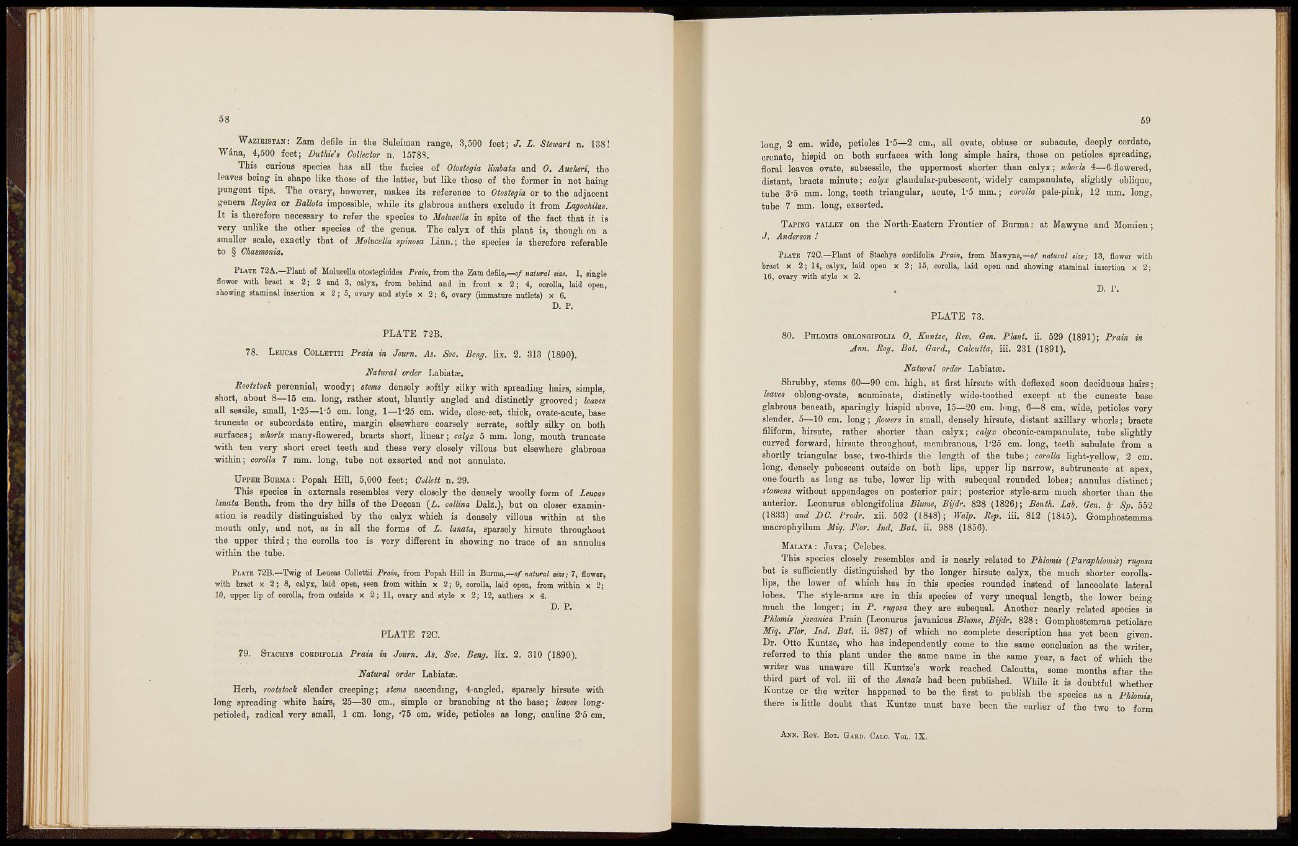
WAZIBISTAN: Zam doiile in the Suleiman range, .3,500 feet; J. L. Siewart n. 138!
Wdna, 4,500 feet; Duthie's Collector n. 1578S.
This curious species has all the facies of Otostegia Umhaia and 0. Aucheri, the
leaves beiug in shape like those of the latter, but like those of the former in not hain^
pungent tips. The ovary, however, makes its reference to Otostegia or to the adjacent
genera Roijlea or Ballota impoesible, while its glabrous anthers exclude it from LagoehUu$.
It is therefore necessary to refer the species to Mohcclla in epite of the fact that it is
very unlike the other species of the genus. The calyx of this plant is, though on a
smaller scale, exactly that of Molucella spinosa Linn.; the species is therefore referable
to § Chamonia.
PLATE 72A.—Plant of Molucella otostegioides Prain, from the Zam defile,—O/ naiuraJ me. 1, eingle
flower with bract x 2; 2 and 3, calyx, from behind and in front * 2; 4, corolla, laid open,
sliowing stamiual insertion x 2; 5, ovary and style x 2; 6, ovary (immature nutlets) x 6.
D. P.
PLATE 72B.
78. LEUCAS COLLETTII Prain in Journ. As. Soc. Beng. lis. 2. 313 (1890).
Natural order Labiatffi.
Rootstock perennial, woody; stems densely softly silky vrith spreading hairs, simple,
short, about 8—15 cm. long, rather stout, bluutly angled and distinctly grooved; leaves
all sessile, small, 1'25—1-3 cm. long, 1—1-25 cm. wide, close-set, thick, ovate-acute, base
truncate or subcordate entire, margin elsewhere coarsely serrate, softly silky on both
surfaces; whorls many-flowered, bracts short, linear; calyx 5 mm. long, mouth truncate
^vith ten very short erect teeth and these very closely villous but elsewhere glabrous
•within; corolla 7 mm. long, tube not exserted and not annulate.
UPPER BURMA: Popah Hill, 5,000 feet; OoUett
This species in externals resembles very closely the densely woolly form of Leueas
lanata Benth. from the dry hills of the Deccan (¿. collina Dalz.}, bat on closer examination
is readily distinguished by the calyx which is densely villous within at the
mouth only, and not, as in all the forms of L. lanata, sparsely hirsute throughout
the upper third; the corolla too is very different in showing no trace of an annulus
within the tube.
PLATE 72B.—Twig of Leuoas Collettii Prain, from Popah Hill in Burma,—O/ natural sise; 7, flower,
•with bract x 2; 8, calyx, laid open, seen from within x 2; 9, corolla, laid open, from within x 2;
10, upper lip of corolla, from outside x 2; 11, ovary and style x 2; 12, anthers x 4.
D. P.
PLATE 72C.
79. STACHYS COSDIPOLIA Prain in Journ. As. Soc. Beng. lis. 2. 310 (1890).
Natural order Labiat®,
Herb, rootstock slender creeping; stems ascending, 4-angled, sparsely hirsute with
long spreading white hairs, 25—30 cm., simple or branching at the base; leaves longpetioled,
radical very flmall, 1 cm. long, -75 cm. wide, petioles as long, cauline 2-5 cm.
long, 2 cm. wide, petioles 1-5—2 cm., all ovate, obtuse or subacute, deeply cordate,
crenate, hispid on both surfaces with long simple hairs, those on petioles spreading,
floral leaves ovate, subsessile, the uppermost shorter than calyx ; wlwrls 4—6-flowered,
distant, bracts minute; calyx glandular-pubescent, widely campanulate, slightly oblique,
tube 3-5 mm. long, teeth triangular, acute, 1'5 mm. ; corolla pale-piiik, 12 mm. long,
tube 7 mm. long, exserted.
TAPING VALLEY on the North-Eastem Frontier of Burma: at Mawyne and Momien;
J. Anderson !
PLATE 720.—Plant of Staobys cordiiolia Prain, from Mawyne,—of natural tize; 13, flower witb
bract X 2 ; 14, oalys, laid open x 2; 16, corolla, laid open and showing staminal insertion x 2;
16, ovary with style x 2.
80. PHLOMIS OBLONGIFOLIA 0. Kuntse, Rev. Gen. Plant, ii. 529 (1891); Prain in
Ann. Rog. Bat. Gard., Calcutta, iii. 231 (1891).
Natural order Labiat®.
Shrubby, stems 60—90 cm. high, at first hirsute with deflexed soon deciduous hairs;
leaves oblong-ovate, acuminate, distinctly wide-toothed except at the cuneate base
glabrous beneath, sparingly hispid above, 15—20 era. h>ng, 6—8 cm. wide, petioles very
slender, 5—10 cm. long; flowers in small, densely hirsute, distant axillary whorls; bracts
filiform, hirsute, rather shorter than calyx; calyx obconic-campanulate, tube slightly
cui-ved forward, hirsute throughout, membranous, l'2o cm. long, teeth subulate from a
shortly triangular base, two-thirds the length of the tube; corolla light-yellow, 2 cm.
long, densely pubescent outside on both lips, upper lip narrow, subtruncate at apex,
one fourth as long as tube, lower lip with subequal rounded lobes; annulus distinct;
stamens without appendages on posterior pair; posterior style-arm much shorter than the
anterior. Leonurus oblongifolius Blume, Bijdr. 828 (1826); Benth. Lah. Gen. ^ Sp. 552
(1883) and DC. I'rodr. xii. 502 (1848); Walp. Rep. iii. 812 (1845). Gomphostemma
macrophyilum Miq. Flor. Jnd. Bat. ii. 988 (1856).
MALAYA : Java; Celebes.
This species closely resembles and is nearly related to Phlomis (Paraphlotnis) rugosa
but is sufBciently distinguished by the longer hirsute calyx, the much shorter corollalipa,
the lower of which has in this species rounded instead of lanceolate lateral
lobes. The style-arms are in this species of very unequal length, the lower being
much the longer; in P. rugosa they are subequal. Another nearly related species is
Phlomis javanica Prain (Leonurus javanicus Blume, Bijdr. 828: Gomphostemma petiolare
Miq. Flor. Ind. Bat. ii. 987J of which no complete description has yet been given.
Dr. Otto Kuntze, who has independently come to the same conclusion as the writer,
referred to this plant under the same name in the same year, a fact of which the
writer was unaware till Kuntze's work reached Calcutta, some months after the
third part of vol. iii of the Annals had been published. While it is doubtful whether
Kuntze or the writer happened to be the first to publish the species as a PhlomU,
there is little doubt that Kuntze must have been the earlier of the two to fomi
ANN. EOY. BOX. GARD. CALC. VOL. I X.